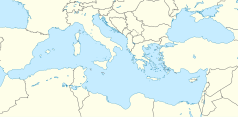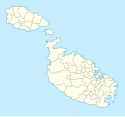Palazzo Dorell
 Fasada frontowa Palazzo Dorell | |
| Państwo | |
|---|---|
| Miejscowość | |
| Adres | Triq Ħal Tarxien |
| Typ budynku | Domek myśliwski |
| Styl architektoniczny | |
| Inwestor | Ignatius Francesco Moscati Falsoni Navarra, hrabia Bahrija[2] |
| Kondygnacje | 2 |
| Ukończenie budowy | 1670 |
| Właściciel | Dino, baron di San Marco |
Palazzo Dorell[3] (fr. Palais d’Aurel[4]) znany też jako Bettina Palace[5], Villa Bettina[3], Villa Dorell[6] (Villa d’Aurel[7]), Xlejli Palace[8], a wśród okolicznych mieszkańców po prostu 'The Palace' (Il-Palazz)[9] – XVII-wieczny pałac w stylu palladianistycznym[1], znajdujący się w miejscowości Gudja na Malcie[10].
Historia
Posiadłość została zbudowana w roku 1670, w czasach rządów Zakonu św. Jana na Malcie, przez hrabiego Ignatiusa Francesco Moscati Falsoni Navarrę, jako dom rodzinny i rezydencja wiejska[9][11]. W roku 1760 pałac został kupiony przez Pietra Paola Falzon d’Aurelle (ang. Dorell) Falzona[2][1], i jest zamiennie nazywany od imienia jego i jego córki Marchesy[12] Lady Bettiny Testaferrata Dorell[13].
Podczas blokady Francuzów (1798–1800) pałac służył jako kwatera główna sił brytyjskich pod dowództwem generała Grahama[3].
Ogrody
Wewnątrz ogrodzonych murem prywatnych ogrodów posiadłości znajduje się wieża Xlejli oraz kaplica[14][4]. W ogrodzie jest też mały cmentarz, gdzie pochowani są brytyjscy żołnierze, którzy polegli podczas francuskiej okupacji Malty[15].
Współcześnie
Współcześnie pałac jest prywatną rezydencją, i nie jest dostępny dla zwiedzających.
Pałac jest zabytkiem 1. klasy na liście Malta Environment and Planning Authority (MEPA) oraz figuruje w spisie National Inventory of the Cultural Property of the Maltese Islands (NICPMI)[3].
Inne rezydencje rodziny Dorell
Arystokratyczna francuska rodzina d’Aurelle posiadała na Malcie również inne wspaniałe rezydencje. Pałac nie powinien być mylony z Palazzo Bettina[16] w Birgu, ani z Casa Dorell w Valletcie[17], które kiedyś też należały do tej rodziny[18].
Przypisy
- ↑ a b c Malta (...) Guide d'Europa. Touring Club Italiano, 2005. ISBN 88-365-3317-5. (wł.).
- ↑ a b Il-Gudja. [zarchiwizowane z tego adresu (2017-07-02)]. (ang.).
- ↑ a b c d Palazzo Dorell. National Inventory of the Cultural Property of the Maltese Islands, 2012-12-28. [zarchiwizowane z tego adresu (2015-11-21)]. (ang.).
- ↑ a b Kenneth Zammit Tabona: Age of Elegance. Miranda Publishers, 2015. (ang.).
- ↑ Dorell Palace and Xlejli Tower Overview in Gudja, Malta. Gozo Tourism Association, Island of Gozo. [zarchiwizowane z tego adresu (2017-07-21)]. (ang.).
- ↑ Shirley Jackewicz Johnston: Splendor of Malta. New York: Rizzoli, 2001, s. 181. ISBN 0-8478-2286-9. (ang.).
- ↑ A history of the British Army in Malta. Malta Family History. (ang.).
- ↑ John Davies Evans: The prehistoric antiquities of the Maltese Islands: a survey. Athlone Press, 1971, s. 198. (ang.).
- ↑ a b Simon Gaul: Malta, Gozo and Comino. New Holland Publishers, 2007, s. 229-230. (ang.).
- ↑ Diploma Long Essays. University of Malta. [dostęp 2017-08-09]. (ang.).
- ↑ The Very Long Hiccup. Origins of the Army Medical Services in Malta. British Army Medical Services and the Malta Garrison. [dostęp 2017-08-09]. (ang.).
- ↑ Lord Nelson's romance with Malta. Azure. [zarchiwizowane z tego adresu (2015-11-21)]. (ang.).
- ↑ Vittoriosa. Palazzo Bettina. discovermalta.com. [zarchiwizowane z tego adresu (2016-03-04)]. (ang.).
- ↑ Gudja – Malta. My Guide Malta. [zarchiwizowane z tego adresu (2016-03-05)]. (ang.).
- ↑ Joseph Cassar Pullicino. The Order of St. John in Maltese Folk-Memory. „Melitensia”. 4, s. 157, 10-12.1949. [dostęp 2022-09-28]. (ang.).
- ↑ L-Abbati tal-Palazz tas-Sinjura Bettina. „Melitensia”. 2, 1939. (malt.).
- ↑ Harry Luke: Malta: An Account and an Apreciation. Harrap, 1949, s. 58. (ang.).
- ↑ Palazzo Bettina. Times of Malta, 2012-04-17. [zarchiwizowane z tego adresu (2016-03-04)]. (ang.).
Media użyte na tej stronie
Autor: Maximilian Dörrbecker (Chumwa), Licencja: CC BY-SA 3.0
Location map of Malta
Autor: NordNordWest, Licencja: CC BY-SA 3.0 de
Location map of the Mediterranean Sea
Blue Shield - the Distinctive emblem for the Protection of Cultural Property. The distinctive emblem is a protective symbol used during armed conflicts. Its use is restricted under international law.
(c) Continentaleurope z angielskiej Wikipedii, CC BY-SA 3.0
Xlejli Tower. The Tower was built much before the palace's construction. The palace is Palazzo Dorell. The tower is found in its gardens.








